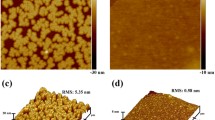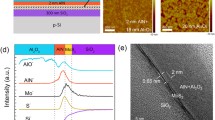Abstract
The quality of the contact is key for the performance enhancement of the MoS2 device. As the oxygen plasma treatment is developed in the fabrication of MoS2 field effect transistor (FET), we demonstrate that the tunneling layer (MoO3) is formed on the top of the MoS2 contact region and the process induced organic residues in the source and drain regions is effectively removed. The formation of MoO3 can degrade the Fermi level pinning effect at the MoS2/metal interface and lowering the Schottky barrier height. And the flatness of the interface has been greatly improved, with the roughness reduced from 0.53 to 0.166 nm. In this paper, we improve the device performance with an on-/off-current ratio increase by four orders of magnitude, a mobility increase by 10 times at room temperature and the 33-fold decrease in contact resistance. This research shows that oxygen plasma treatment is a promising method for the integration of MoS2 FET in the future.






Similar content being viewed by others
References
K.S. Novoselov, A.K. Geim, S.V. Morozov et al., Electric field effect in atomically thin carbon films. Science 306(5696), 666–669 (2004)
F. Schwierz, Graphene transistors. Nat. Nanotechnol. 5(7), 487–496 (2010)
R. Zhang, Z. Wu, X.J. Li et al., Aharonov-Bohm effect in monolayer phosphorene nanorings. Phys. Rev. B 95(12), 125418 (2017)
M.Y. Li, S.K. Su, H.P. Wong et al., How 2D semiconductors could extend Moore’s law. Nature 567(7747), 169–170 (2019)
Z.Z. Zhang, Z.H. Wu, K. Chang et al., Resonant tunneling through S- and U-shaped graphene nanoribbons. Nanotechnology 20(41), 415203 (2009)
F. Schwierz, J. Pezoldt, R. Granzner, Two-dimensional materials and their prospects in transistor electronics. Nanoscale 7(18), 8261–8283 (2015)
S. Guo, Y. Zhang, Y. Ge et al., 2D V-V binary materials: status and challenges. Adv. Mater. 31(39), e1902352 (2019)
S. Najmaei, Z. Liu, P.M. Ajayan et al., Thermal effects on the characteristic Raman spectrum of molybdenum disulfide (MoS2) of varying thicknesses. Appl. Phys. Lett. 100(1), 013106 (2012)
H. Liu, A.T. Neal, Y.C. Du et al., Fundamentals in MoS2 transistors: dielectric, scaling and metal contacts. ECS Trans. 58(7), 203–208 (2013)
H. Liu, A.T. Neal, P.D. Ye, Channel length scaling of MoS2 MOSFETs. ACS Nano 6(10), 8563–8569 (2012)
A. Rai, H. Movva, A. Roy et al., Progress in contact, do** and mobility engineering of MoS2: an atomically thin 2D semiconductor. Crystals 8(8), 316 (2018)
J. Pei, J. Yang, T. Yildirim et al., Many-body complexes in 2D semiconductors. Adv. Mater. 31(2), e1706945 (2019)
Z. Huang, W. Han, H. Tang et al., Photoelectrochemical-type sunlight photodetector based on MoS2/graphene heterostructure. 2D Mater. 2(3), 035011 (2015)
Y. Jiang, L. Miao, G. Jiang et al., Broadband and enhanced nonlinear optical response of MoS2/graphene nanocomposites for ultrafast photonics applications. Sci. Rep. 5, 16372 (2015)
B. Radisavljevic, A. Radenovic, J. Brivio et al., Single-layer MoS2 transistors. Nat. Nanotechnol. 6(3), 147–150 (2011)
J.H. Kang, W. Liu, K. Banerjee, High-performance MoS2 transistors with low-resistance molybdenum contacts. Appl. Phys. Lett. 104(9), 093106 (2014)
C.D. English, G. Shine, V.E. Dorgan et al., Improving Contact Resistance in MoS2 Field Effect Transistors, in 2014 72nd Annual Device Research Conference (Drc), (2014), pp. 193–194
S.X. Wu, Y. Zeng, X.B. Zeng et al., High-performance p-type MoS2 field-effect transistor by toroidal-magnetic-field controlled oxygen plasma do**. 2D Mater. (2019). https://doi.org/10.1088/2053-1583/aafe2d
X. Cui, E.M. Shih, L.A. Jauregui et al., Low-temperature ohmic contact to monolayer MoS2 by van der waals bonded Co/h-BN electrodes. Nano Lett. 17(8), 4781–4786 (2017)
W. Park, Y. Kim, S.K. Lee et al., Contact resistance reduction using Fermi level de-pinning layer for MoS2 FETs. 2014 IEEE International Electron Devices Meeting (Iedm), (2014)
Y. Liu, J. Guo, E. Zhu et al., Approaching the Schottky-Mott limit in van der Waals metal-semiconductor junctions. Nature 557(7707), 696–700 (2018)
C. Gong, L. Colombo, R.M. Wallace et al., The unusual mechanism of partial Fermi level pinning at metal-MoS2 interfaces. Nano Lett. 14(4), 1714–1720 (2014)
K.-A. Min, J. Park, R.M. Wallace et al., Reduction of Fermi level pinning at Au–MoS2 interfaces by atomic passivation on Au surface. 2D Mater. 4(1): 015019 (2016)
A.T. Neal, H. Liu, J.J. Gu et al. Metal contacts to MoS2: a two-dimensional semiconductor, in Device Research Conference. (2012)
M.H. Guimaraes, H. Gao, Y. Han et al., Atomically thin ohmic edge contacts between two-dimensional materials. ACS Nano 10(6), 6392–6399 (2016)
Y. Liu, H. Nan, X. Wu et al., Layer-by-layer thinning of MoS2 by plasma. ACS Nano 7(5), 4202–4209 (2013)
N. Kang, H.P. Paudel, M.N. Leuenberger et al., Photoluminescence quenching in single-layer MoS2 via oxygen plasma treatment. J. Phys. Chem. C 118(36), 21258–21263 (2014)
Y. Zhang, J. Liu, Y. Pan et al., The evolution of MoS2 properties under oxygen plasma treatment and its application in MoS2 based devices. J. Mater. Sci.: Mater. Electron. 30(19), 18185–18190 (2019)
S. Chuang, C. Battaglia, A. Azcatl et al., MoS2 P-type transistors and diodes enabled by high work function MoOx contacts. Nano Lett. 14(3), 1337–1342 (2014)
N. Kaushik, D. Karmakar, A. Nipane et al., Interfacial n-do** using an ultrathin TiO2 layer for contact resistance reduction in MoS2. ACS Appl. Mater. Interfaces 8(1), 256–263 (2016)
A. Dankert, L. Langouche, M.V. Kamalakar et al., High-performance molybdenum disulfide field-effect transistors with spin tunnel contacts. ACS Nano 8(1), 476–482 (2014)
C.S. K, R.C. Longo, R. Addou et al., Impact of intrinsic atomic defects on the electronic structure of MoS2 monolayers. Nanotechnology 25(37), 375703 (2014)
A. Castellanos-Gomez, M. Barkelid, A.M. Goossens et al., Laser-thinning of MoS2: on demand generation of a single-layer semiconductor. Nano Lett. 12(6), 3187–3192 (2012)
H. Zhu, X. Qin, L. Cheng et al., Remote plasma oxidation and atomic layer etching of MoS2. ACS Appl. Mater. Interfaces 8(29), 19119–19126 (2016)
Acknowledgements
This work was supported by the MOST of China (Grant No. 2016YFA0202300), the NSFC (Grant Nos. 61774168 and 11764008).
Author information
Authors and Affiliations
Corresponding authors
Additional information
Publisher's Note
Springer Nature remains neutral with regard to jurisdictional claims in published maps and institutional affiliations.
Rights and permissions
About this article
Cite this article
Zhang, Y., Jia, K., Liu, J. et al. The optimization of contact interface between metal/MoS2 FETs by oxygen plasma treatment. J Mater Sci: Mater Electron 31, 9660–9665 (2020). https://doi.org/10.1007/s10854-020-03511-7
Received:
Revised:
Accepted:
Published:
Issue Date:
DOI: https://doi.org/10.1007/s10854-020-03511-7




